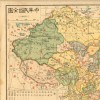Donnerstag | 18.00 Uhr | Defining 'China‘ in the Empire-to-Nation Transition Chinese debates on the territory of the new Republic of China, 1904-1915 Joseph W. Esherick, Professor Emeritus, University of California  Map early republican China Of all the world’s great empires, China alone kept its territory basically intact during the empire-to-nation transition. In nationalist historiography that claims 5000 years of Chinese civilization, this achievement is unproblematic. Yet the present territory of China is much larger than the historic extent of China before the seventeenth century, reflecting the vast expansion of the empire under the Manchu rulers of the Qing dynasty (1644-1912). The Manchus were overthrown in the 1911 Revolution, whose ideological justification was Han Chinese nationalism. How did the architects of that revolution imagine the territory of the new Republic of China? How did they justify the inclusion of the culturally distinct Mongol, Tibetan, and Muslim regions? And how did they succeed in including those areas, with the exception of Outer Mongolia, in the Republic (and now the People’s Republic) of China? Adresse Karl Jaspers Zentrum, Gebäude 4400 112 Voßstraße 2 69115 Heidelberg Veranstalter Institut für Sinologie Homepage Veranstalter www.zo.uni-heidelberg.de/sinologie Kontakt |